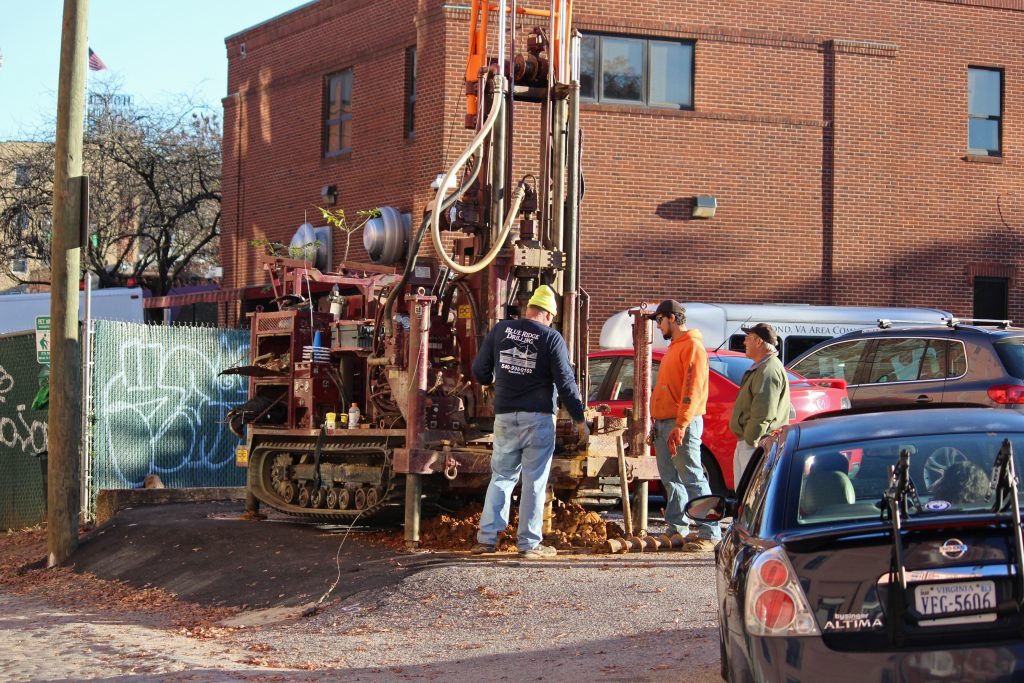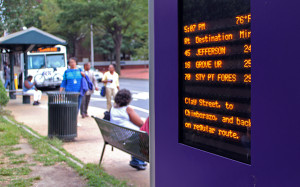
A drill bores down into a surface parking lot next to the Salvation Army at Grace and Foushee streets. Photo by Michael Thompson.
After about a decade of searching and with a deadline looming, the Greater Richmond Transit Co. is working to narrow down a list of potential sites for a large permanent bus transfer center that would replace a temporary stop near City Hall.
GRTC has enlisted Buffalo, New York-based engineering firm Wendel Cos., which has offices in Richmond, to research the pros and cons of various sites around the city. Wendel will present its findings to GRTC early next year.
One of the sites under consideration is 20 W. Grace St. downtown, where this week Wendel has been drilling holes in a surface parking lot to take soil samples. The 0.45-acre lot is owned by the Salvation Army, which has offices next door at 2 W. Grace St.
GRTC spokeswoman Carrie Rose Pace confirmed the samples are being taken to determine whether the property would make a suitable site for a transfer center.
Ron Reekes, a Wendel Cos. regional manager, said similar work is being done for a handful of other sites in Richmond. Neither he nor Rose Pace would identify those other locations.

Bus passengers can currently make transfers at a temporary site on Ninth Street downtown. Photo by Evelyn Rupert.
“This site is just like several other sites,” Reekes said. “All we’re doing here is due diligence. We’re just gathering information.”
Conceptual drawings for the Grace Street site obtained by BizSense show a large transfer center over what is now two Salvation Army-owned parcels and a third lot at 100 W. Grace St. currently owned by Richmond’s Department of Public Works.
Steven Batsche, regional Salvation Army director, said the property is not for sale.
The development, as shown in the drawings, would include 14 bus bays and two multi-story buildings with room for a parking garage and offices and runs along West Grace Street between North Jefferson and North Foushee streets. The three parcels total 1.24 acres.
The search for a permanent transfer center site comes as GRTC faces at least tentative deadlines on the temporary transfer plaza that was set up along North Ninth Street in 2014.
It was asked to move there by the city of Richmond as it prepared for two major bike races. Transfers had previously taken place along East Broad Street downtown, with no formal facility.
Rose Pace said the city gave GRTC no hard date to leave the temporary site. According to GRTC’s website, it planned to use the temporary transfer plaza for between two and three years.
“Our greatest need for a property downtown is a transfer center,” Rose Pace said. “In 2016, that obviously is going to be an important priority.”
She said the process to move from one location to another could take about a year of planning and scheduling.”
GRTC is also preparing to begin construction on its bus rapid transit project, an express system that will run from Rocketts Landing to Willow Lawn. Wendel is doing design work on that project.
The search for a transfer center site has been going on for at least a decade. In that time, more than a dozen sites have been reviewed, including Main Street Station in 2008.
GRTC is owned by the city and Chesterfield County. It’s funding comes from those localities, among other sources.
Katie Demeria contributed to this report.
Clarification: A previous version of this story stated that the city gave GRTC a year after September’s UCI bike race to identify a site for a permanent transfer center. No hard date was given by the city.

A drill bores down into a surface parking lot next to the Salvation Army at Grace and Foushee streets. Photo by Michael Thompson.
After about a decade of searching and with a deadline looming, the Greater Richmond Transit Co. is working to narrow down a list of potential sites for a large permanent bus transfer center that would replace a temporary stop near City Hall.
GRTC has enlisted Buffalo, New York-based engineering firm Wendel Cos., which has offices in Richmond, to research the pros and cons of various sites around the city. Wendel will present its findings to GRTC early next year.
One of the sites under consideration is 20 W. Grace St. downtown, where this week Wendel has been drilling holes in a surface parking lot to take soil samples. The 0.45-acre lot is owned by the Salvation Army, which has offices next door at 2 W. Grace St.
GRTC spokeswoman Carrie Rose Pace confirmed the samples are being taken to determine whether the property would make a suitable site for a transfer center.
Ron Reekes, a Wendel Cos. regional manager, said similar work is being done for a handful of other sites in Richmond. Neither he nor Rose Pace would identify those other locations.

Bus passengers can currently make transfers at a temporary site on Ninth Street downtown. Photo by Evelyn Rupert.
“This site is just like several other sites,” Reekes said. “All we’re doing here is due diligence. We’re just gathering information.”
Conceptual drawings for the Grace Street site obtained by BizSense show a large transfer center over what is now two Salvation Army-owned parcels and a third lot at 100 W. Grace St. currently owned by Richmond’s Department of Public Works.
Steven Batsche, regional Salvation Army director, said the property is not for sale.
The development, as shown in the drawings, would include 14 bus bays and two multi-story buildings with room for a parking garage and offices and runs along West Grace Street between North Jefferson and North Foushee streets. The three parcels total 1.24 acres.
The search for a permanent transfer center site comes as GRTC faces at least tentative deadlines on the temporary transfer plaza that was set up along North Ninth Street in 2014.
It was asked to move there by the city of Richmond as it prepared for two major bike races. Transfers had previously taken place along East Broad Street downtown, with no formal facility.
Rose Pace said the city gave GRTC no hard date to leave the temporary site. According to GRTC’s website, it planned to use the temporary transfer plaza for between two and three years.
“Our greatest need for a property downtown is a transfer center,” Rose Pace said. “In 2016, that obviously is going to be an important priority.”
She said the process to move from one location to another could take about a year of planning and scheduling.”
GRTC is also preparing to begin construction on its bus rapid transit project, an express system that will run from Rocketts Landing to Willow Lawn. Wendel is doing design work on that project.
The search for a transfer center site has been going on for at least a decade. In that time, more than a dozen sites have been reviewed, including Main Street Station in 2008.
GRTC is owned by the city and Chesterfield County. It’s funding comes from those localities, among other sources.
Katie Demeria contributed to this report.
Clarification: A previous version of this story stated that the city gave GRTC a year after September’s UCI bike race to identify a site for a permanent transfer center. No hard date was given by the city.



I’d like to pose a challenge to the planners of the BRT. Hoed will you overcome the homeless and drug trafficking issues that currently pervade the use of the bus stop kiosks downtown today? I think it’s an issue that detracts from ridership especially on bad weather days. It also is deterrent to businesses located near the bus stops. I often consider that ridership might increase if the benches and kiosks were removed. But how do we prevent the large new BRT stops from becoming fancy homeless shelters and drug trade locations?
Excellent scoop. I personally have advocated for block bounded by 1st 2nd, Marshall and Broad to be the site, coupled with apartment development. GRTC stated just a year ago that block was too small. That is why GRTC rejected it, even though it is ripe for development have been largely bought up by Douglas Jamal, who is doing CFB. This is a perfect block, one that could help give more impetus to Jackson Ward and the more neglected north side of Broad. If needed, the EDA has a parking lot for sale at 2nd and Marshall that also could be… Read more »